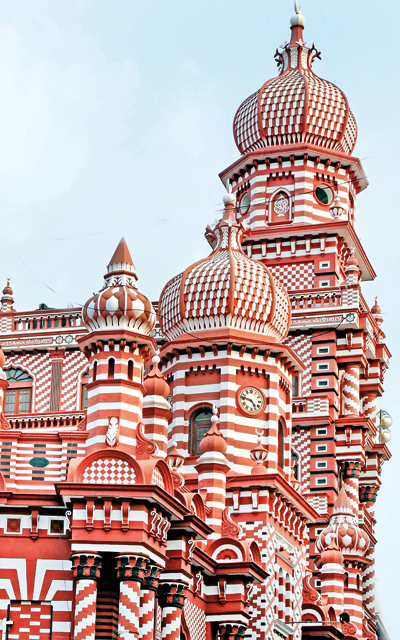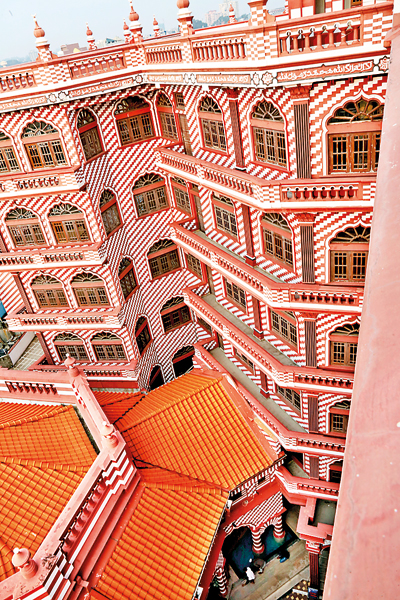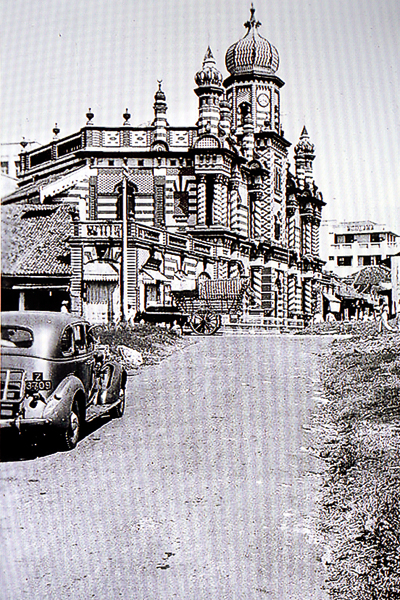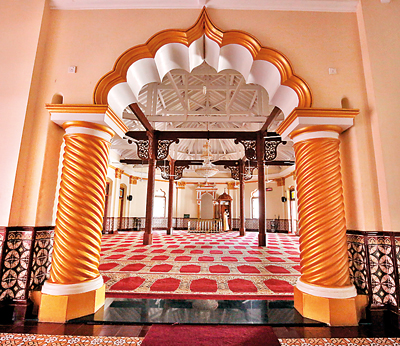Spiritual sanctuary in bustling Pettah

Red Mosque: A beautiful haven that has stood tall for more than a century in drab Pettah. Pix by M.A. Pushpa Kumara
Set amidst the crush of tiny and big shops in the hustle and bustle of Pettah with the Colombo harbour as its backdrop, there is a stunningly beautiful sanctuary to where once you step in, serenity and tranquillity enshroud you like a mantle.
Unique are many of the facets of the Red Mosque from its very colour to the shape of its domes, the designs of its hand-painted bricks and the number of people who enter not only to pray but also to have a look at this beauty amidst the drab and overcrowded Pettah.
The Red Mosque is known by many names – Rathu Palliya in Sinhala, Samman Kottu Palli in Tamil and its official Arabic name of Al Masjid Al Jamiul Alfar which adorns its entrance arch both in English and Arabic. People in their thousands poured into the Red Mosque on Friday, as Muslims across the country celebrated the Holy Prophet’s birthday on Tuesday.
This is the most crowded mosque in Sri Lanka, with as many as 12,000 trooping in for the Friday congregational prayers. The old building and new, now cover 50,000 sq feet and have the capacity to accommodate as many as 16,000 worshippers.
Several aspects of the Red Mosque make it one of its kind in the whole world, says the mosque’s Coordinator and Tour Guide M.M. Ruzni.
Pomegranate is the shape of its main dome, with the subsequently-built domes, following suit, unlike the commonly-used onion shape, while even the colour is similar to what one finds when this fruit is cut open, he says, before taking us back down the corridors of time when South Indian Muslim traders congregated in these very streets between the 17th and 19th centuries. These traders needed to pray five times a day and how could they do so in a busy commercial area. This is what propelled them to buy this land and build the mosque.

M.M. Ruzni
The design and architecture of the mosque was by H.L. Saibo Lebbe who was heavily influenced by the style of Indian mosques and followed Indo-Saracen architecture, encompassing both Indian and Islamic traditions.
The very first low-slung building which adorned the land, construction of which was started in 1908, more than a century ago, and completed the following year, had only the ground floor and the first floor, with intricately-carved columns of teak (trees straight from Puttalam) holding up the next level and the roof. This building has been retained in all its simple grandeur, along with the first dome, imitating the pomegranate shape and the red-white mix of the fruit’s interior when halved, being the colour of choice.
The clock on the original dome brought all the way from Ukraine is still working more than 110 years later.
When asked why this mosque is red, when usually they are green, Mr. Ruzni dispels the commonly-held views that historic records or religious scriptures have laid down a specific colour. Green has come about from cultural thinking.

The new section that was added 15 years ago
Referring to the specific features that denote a mosque, he says that it is the dome which in the early days sans mics was built at the centre of the prayer hall for better acoustics and to carry the echoes. It also helped the devotees to identify the mosque from afar.
“Mosques took shape according to Islamic architecture and comprise domes and minarets or slim towers, giving prominence to a niche-shaped design. People were called to prayer by the muezzin from the minaret,” says Mr. Ruzni.
More recently, 15 years ago, the Red Mosque was expanded to accommodate the crowds which come in to pray, with six more floors with prayer halls, surrounded by seven more pomegranate-shaped domes and 49 minarets, being built by the side of the old building. Five entrances give access to the Red Mosque, two off Second Cross Street for male worshippers and one for tourists; and one each for female and male worshippers off Main Street.
“Nothing was changed in the old building, while in the six-storey new wing, the old architectural style has been replicated,” says Mr. Ruzni.
Another extraordinary feature is its stark colour, with each brick being hand-painted white or red in four different designs – checkered, jagged, striped or spiral.
Arabic calligraphy adorns the top of the building extolling the basic concept of Islam…..There is no God in this world. But Allah is the God and He is the greatest and He is the Master. Prophet Mohammed is the final messenger to this world and Allah’s servant,” says Ruzni.
A rare feature is that the Red Mosque, unlike many others, is open to visitors and tourists, who are politely requested to cover themselves, if in scanty attire, and walk in, with abayas hanging just short of the entrance for their convenience.

Old Pettah: A picture from the past
As many as 100 tourists come a-visiting daily between 9.30 a.m. and 5.30 p.m., says Mr. Ruzni, adding that the numbers increase to 150 over the weekends and as we chat several foreign couples step in to be welcomed graciously.
A tour of the Red Mosque takes us through the ground floor courtyard open to the skies essential for natural ventilation and past the hall where the faithful are engaged in intense prayer, getting a look at the ablution area with its pool of water where the devotees have to ritually wash their hands, faces and feet before entering the hall.
The South Indians use the pond system and we have kept it to protect the earlier design but those who want to use taps have those facilities as well, says Mr. Ruzni.
The ground floor and first floor, carpeted in red, exude serenity and the teak columns and teak furniture add to their beauty. Facing the first floor prayer hall, up against the wall is the Mimbar, once again made of teak, with three steps (unlike in Egypt which would have more steps depending on the audience) leading up to the seat, where the Imam sits to deliver his 45-minute sermon on Friday during congregational prayers. By the side of the Mimbar is a curved space, a niche called Mihrab, from where the Moulavi would intone prayers from the Holy Quran, which would get echoed across the hall.
“We have no statues or images, as we Muslims pray directly to God and don’t need anyone to intercede on our behalf,” says Mr. Ruzni.

Interior of the mosque: The Mimbar and the Mihrab
Just outside the hall near a large window will stand the muezzin at the mic, summoning people to prayer.
On the red carpet with its lines, he shows us how the faithful pray, facing Mecca and standing should-to-shoulder which denotes equality and brotherhood, be they rich or poor, white or black. The different postures of prayer are standing, bowing and prostrating themselves on the floor.
From the sixth floor, we see the ships, some at anchor in the harbour, some entering and others departing. As we leave the Red Mosque and join the throngs going hither and thither, we see in our mind’s eye the Muslim traders of yore disembarking at the harbour, with the Red Mosque beckoning them to a safe haven.


